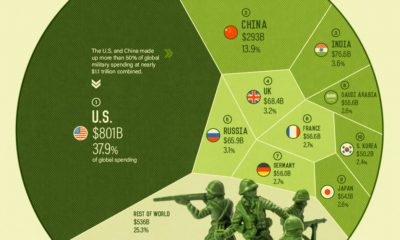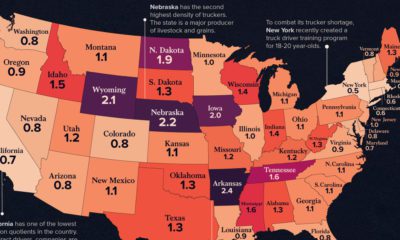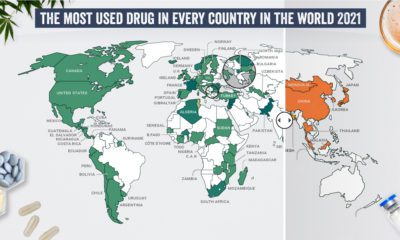Although the damage of the opioid epidemic is well documented, what people might not know is that it has escalated in three distinct waves. We pull the latest statistics from the UN World Drug Report 2020 to uncover the scope of the opioid crisis in the U.S., and how national drug-related death rates compare to other countries.
Three Waves of the Opioid Crisis
According to the CDC, the opioid epidemic can be traced back to the 1990s, when opioids started being over-prescribed for pain relief purposes.
1990s – Wave 1 Over-prescription of opioids for pain relief, including natural opioids, semi-synthetic opioids, and methadone. Addiction risks were widely downplayed. 2010 – Wave 2 Heroin-related overdose deaths on the rise. 2013 – Wave 3 Synthetic opioid-related deaths on the rise, particularly fentanyl and tramadol.
Here’s how that breaks down in terms of opioid-related overdose deaths over the years. Note that by the year 2018, 67% of overdose deaths involved synthetic opioids such as fentanyl. Overdose deaths from synthetic opioids such as fentanyl and tramadol shot up by over 4,000% between 1999-2018. This can be attributed to two things: their relative potency, and the minute quantities of each that qualify as a lethal dose. As per the medical and legal standard, opioids are often compared to morphine. To that end, heroin is 2-5x stronger—while fentanyl is 50-100x more potent. Put another way, roughly a dime-size or 10-12mg of heroin is considered a lethal dose, compared to only 1-2mg of fentanyl. What’s worse, fentanyl is typically mixed with other types of drugs such as heroin or cocaine to increase their effects, which is how it ends up unintentionally ingested. Between 2008-2017, drug-use disorders as a whole claimed the most healthy lives due to poor health or early deaths—measured in disability-adjusted life years (DALYs)—followed in close second by opioid use disorders.
The Death Toll of U.S. Drug Overdoses
It’s undeniable that the opioid epidemic in America has caused significant harm to communities. But how does the U.S. drug crisis compare to the same issue in other countries? The UN Drug Report further puts these numbers into perspective by comparing drug-related deaths per million population. Note that the source also compiled the total deaths across years for selected countries. With 314.5 deaths per million, the U.S. by far had the highest proportion of drug-related deaths per million people in 2018. It also had the highest overall number at 67.4K deaths.
Elephant in the Room?
Another drug rearing its head on the streets is carfentanil. Formerly developed as ‘elephant tranquilizer’, this synthetic opioid is similar in appearance to other illicit drugs such as heroin, making it indistinguishable when mixed in. However, there’s one big problem—carfentanil is 100x more potent than fentanyl itself. In response to the continued crisis, an additional $35.7 billion was requested for counter-drug funding efforts in the FY2021 Budget. This amount is expected to go towards prevention and treatment efforts ($18.6 billion) and law enforcement efforts ($17.1 billion) both domestically and internationally. But will these efforts properly combat the crisis, or are we already in the midst of a fourth wave of the opioid epidemic? on Even while political regimes across these countries have changed over time, they’ve largely followed a few different types of governance. Today, every country can ultimately be classified into just nine broad forms of government systems. This map by Truman Du uses information from Wikipedia to map the government systems that rule the world today.
Countries By Type of Government
It’s important to note that this map charts government systems according to each country’s legal framework. Many countries have constitutions stating their de jure or legally recognized system of government, but their de facto or realized form of governance may be quite different. Here is a list of the stated government system of UN member states and observers as of January 2023: Let’s take a closer look at some of these systems.
Monarchies
Brought back into the spotlight after the death of Queen Elizabeth II of England in September 2022, this form of government has a single ruler. They carry titles from king and queen to sultan or emperor, and their government systems can be further divided into three modern types: constitutional, semi-constitutional, and absolute. A constitutional monarchy sees the monarch act as head of state within the parameters of a constitution, giving them little to no real power. For example, King Charles III is the head of 15 Commonwealth nations including Canada and Australia. However, each has their own head of government. On the other hand, a semi-constitutional monarchy lets the monarch or ruling royal family retain substantial political powers, as is the case in Jordan and Morocco. However, their monarchs still rule the country according to a democratic constitution and in concert with other institutions. Finally, an absolute monarchy is most like the monarchies of old, where the ruler has full power over governance, with modern examples including Saudi Arabia and Vatican City.
Republics
Unlike monarchies, the people hold the power in a republic government system, directly electing representatives to form government. Again, there are multiple types of modern republic governments: presidential, semi-presidential, and parliamentary. The presidential republic could be considered a direct progression from monarchies. This system has a strong and independent chief executive with extensive powers when it comes to domestic affairs and foreign policy. An example of this is the United States, where the President is both the head of state and the head of government. In a semi-presidential republic, the president is the head of state and has some executive powers that are independent of the legislature. However, the prime minister (or chancellor or equivalent title) is the head of government, responsible to the legislature along with the cabinet. Russia is a classic example of this type of government. The last type of republic system is parliamentary. In this system, the president is a figurehead, while the head of government holds real power and is validated by and accountable to the parliament. This type of system can be seen in Germany, Italy, and India and is akin to constitutional monarchies. It’s also important to point out that some parliamentary republic systems operate slightly differently. For example in South Africa, the president is both the head of state and government, but is elected directly by the legislature. This leaves them (and their ministries) potentially subject to parliamentary confidence.
One-Party State
Many of the systems above involve multiple political parties vying to rule and govern their respective countries. In a one-party state, also called a single-party state or single-party system, only one political party has the right to form government. All other political parties are either outlawed or only allowed limited participation in elections. In this system, a country’s head of state and head of government can be executive or ceremonial but political power is constitutionally linked to a single political movement. China is the most well-known example of this government system, with the General Secretary of the Communist Party of China ruling as the de facto leader since 1989.
Provisional
The final form of government is a provisional government formed as an interim or transitional government. In this system, an emergency governmental body is created to manage political transitions after the collapse of a government, or when a new state is formed. Often these evolve into fully constitutionalized systems, but sometimes they hold power for longer than expected. Some examples of countries that are considered provisional include Libya, Burkina Faso, and Chad.













